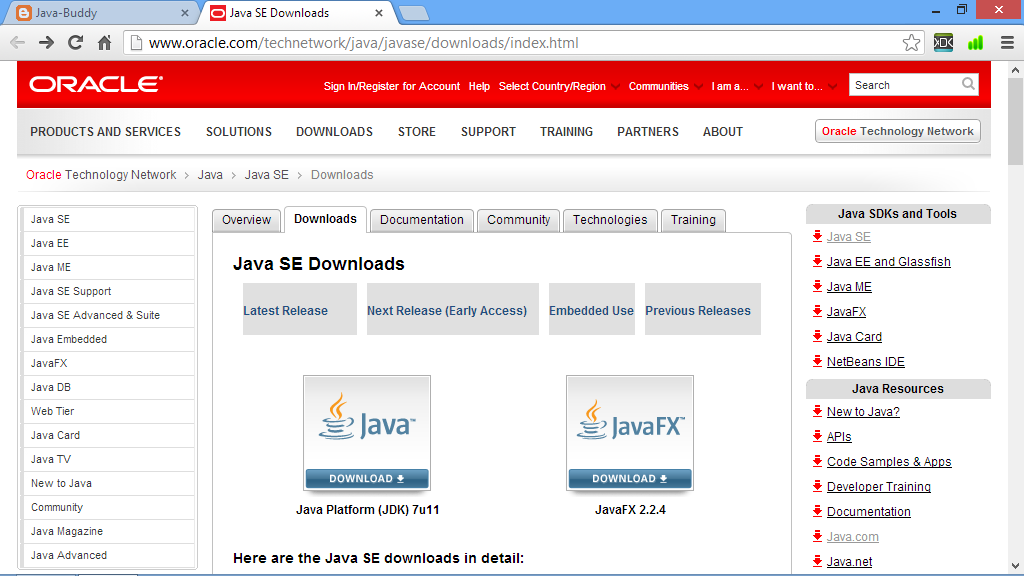
- #Java se development kit 8 tutorial install
- #Java se development kit 8 tutorial update
- #Java se development kit 8 tutorial code
Java HotSpot(TM) 64-Bit Server VM (build 25. Java(TM) SE Runtime Environment (build 1.8.0_291-b10) It should output the following: java version "1.8.0_291" Let the system know where JRE is installed: sudo update-alternatives -install "/usr/bin/java" "java" "/usr/local/java/jre1.8.0_291/bin/java" 1Īfter that’s done, check the installation by running: java -version To save space, delete the tarball by running: sudo rm jre-8u291-linux-圆4.tar.gz Unpack the tarball: sudo tar zxvf jre-8u291-linux-圆4.tar.gz
#Java se development kit 8 tutorial install
Go into the install directory: cd /usr/local/java Move the JRE binaries into the directory: sudo mv jre-8u291-linux-圆4.tar.gz /usr/local/java InstallingĬreate a directory to install JRE in with: sudo mkdir /usr/local/java
#Java se development kit 8 tutorial update
Oracle does not currently offer JRE packages for Java 11 or above from their website so, for this tutorial, we will use the Oracle HotSpot JRE version to be 8u291 (Java 8, update 291). An Oracle account is needed to download the Oracle HotSpot JRE. tar.gz (tarball) by heading over to their website. Installing Oracle HotSpot JRE Downloading the Oracle HotSpot JRE binariesĭownload JRE binaries in. In the next step we’ll install Oracle HotSpot JRE. Follow the steps Show more View Detail Overview (Java SE 18 & JDK 18) - Oracle 2 days ago Version 18 API Specification. And one of the most common way to create the java REST API is using Jersey. We can create a REST API in java using several ways.
#Java se development kit 8 tutorial code
(Although the output may change in the future as new Java versions are promoted to LTS status, or the current LTS version receives updates.) Java API Tutorial - Examples Java Code Geeks - 2022 2 days ago OpenJDK 64-Bit Server VM (build 11.0.11+9-Ubuntu-0ubuntu2, mixed mode) OpenJDK Runtime Environment (build 11.0.11+9-Ubuntu-0ubuntu2) Used by over 10 million developers and running on 56 billion devices globally, the Java Platform truly moves the. It should output the following: openjdk version "11.0.11" We can check if OpenJDK JRE was properly installed by running: java -version To install the OpenJDK JRE, we run: sudo apt install default-jre

(Alternatively, you may opt to use a specific Java version, using for example the openjdk-11-jre package as updates are released for that version of the Java Virtual Machine, that packages will be updated, allowing you to stick to the latest and greatest update of one specific version of the Java language.) The default-jre is an excellent choice for most situations, thanks to the outstanding track of backwards compatibility of the Java Virtual Machine. Ubuntu offers the default-jre package, which is regularly updated to ship the latest version of the current OpenJDK JRE in Long Term Support (LTS). Moreover, the non LTS versions of Java are bringing a steady stream of innovation into the language, and also see some adoption. JDK 8 is a superset of JRE 8, and contains everything that is in JRE 8, plus tools such as the compilers and debuggers necessary for developing applets and applications. Nowadays, Java 11 is the current Long Term Support (LTS) version, but Java 8 is still widely used. Oracle has two products that implement Java Platform Standard Edition (Java SE) 8: Java SE Development Kit (JDK) 8 and Java SE Runtime Environment (JRE) 8.

With new versions of Java released every 6 months, there are multiple versions available for use.


 0 kommentar(er)
0 kommentar(er)
